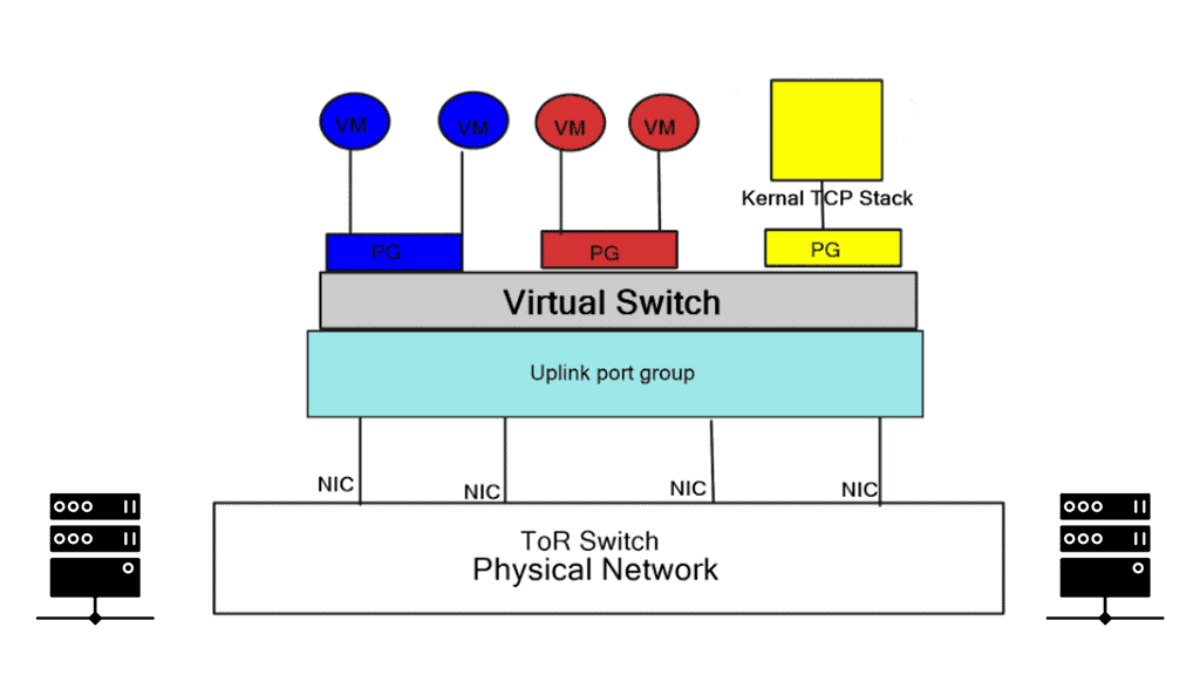An Application Virtual Switch (AVS) enables virtual networking for applications. It acts as a bridge between virtual and physical network infrastructures.
Virtual networking is transforming how businesses manage their network architecture. An Application Virtual Switch streamlines this process by providing a dynamic, software-based interface that can manage network services more efficiently than traditional hardware. Designed to support high-performance virtual environments, AVS facilitates the direct communication between virtual machines and the physical network, enhancing data throughput and reducing latency.
By integrating seamlessly with virtualization platforms, AVS simplifies network configuration and automates many tasks, making network management more agile. It allows IT professionals to allocate, monitor, and adjust networking resources on-the-fly to meet the evolving demands of applications and services. Embracing this technology helps organizations reduce costs and improve scalability, which is crucial in today’s fast-paced digital landscape.

Credit: fastercapital.com
Table of Contents
What Is A Virtual Switch (vswitch)?
A virtual switch (vSwitch) operates within a virtualized environment, directing network traffic between virtual machines (VMs) and various networks. This key component of network virtualization mimics the functionality of a physical switch, facilitating communication and resource allocation for applications.
Diving into the realm of network virtualization, a virtual switch (vSwitch) plays a fundamental role. To put it simply, a vSwitch is a software application that allows virtual machines (VMs) to communicate with each other within a host computer or across connected hosts.
Unlike a physical switch that manages traffic within a local network, a vSwitch directs networking traffic more dynamically between VMs and external networks.
Key Functions Of A Virtual Switch
The virtual switch is no slouch when it comes to its responsibilities within a virtualized environment. Let’s bullet out these functions for clarity:
- Traffic Management: Acts as a gatekeeper, controlling and directing network traffic between multiple VMs on the same physical host.
- VLAN Segmentation: Provides isolation by separating VMs into distinct virtual networks (VLANs), bolstering security and traffic management.
- Policy Enforcement: Employs network policies to ensure VM traffic adheres to established rules, such as access control lists and QoS parameters.
As these points showcase, a vSwitch is akin to a traffic cop and rule-enforcer all-in-one—ensuring smooth and secure network operations among virtual ecosystems.
Advantages Of Using A Vswitch
Now, you might be wondering why opt for a vSwitch in place of its tangible counterpart? Well, let’s break this down into tangible benefits:
- Flexibility: Enables on-the-fly changes in network configurations without needing to tweak physical hardware, allowing for agile adaptation to varying needs.
- Cost-Efficiency: Eliminates the need for excessive physical networking gear, translating into lower capital and operational expenses.
- Security: Enhances security features such as isolation, firewalls, and intrusion prevention systems tailored for virtual networks.
These advantages reaffirm a vSwitch’s position as not just a cost-efficient solution but also a flexible and secure network management tool in virtual settings.
Challenges With Virtual Switches
Amidst its strengths, the vSwitch is not without its challenges:
- Scalability Concerns: Needs meticulous management to scale effectively as more VMs are added to the system.
- Complexity: More complex to configure and manage compared to traditional switches due to the intricacies of virtualization.
However, with a keen understanding and strategic planning, these hurdles can be addressed, allowing you to fully harness the power of virtual switch technology.
Vswitch Vs. Physical Switch
To sum up, a vSwitch is a virtual networking device that offers substantial benefits over traditional physical switches in terms of flexibility, cost savings, and security. As virtualization continues to be a driving force in IT infrastructure, understanding and leveraging virtual switches is key to optimizing and securing your virtual environments.
What Is A Virtual Switch Used For?
An Application Virtual Switch operates within a virtualized environment, routing network traffic between different virtual machines. It plays a crucial role in managing communication across virtualized applications, ensuring efficient and secure data transfer.
Virtual switches are a fundamental component in any virtualized networking environment. They operate much like traditional physical network switches, but with greater flexibility and without the physical constraints. Virtual switches allow virtual machines (VMs) on the same host to communicate with each other as well as with the broader network, facilitating an efficient and secure data flow.
Enabling Virtual Machine Communication
- Segments traffic:
Virtual switches help in carving out distinct network segments that can isolate communication for specific virtual machines, ensuring sensitive or critical workloads remain private and protected.
- Orchestrates network policies:
These switches enforce network policies at the virtual machine level. They apply rules for network access, bandwidth limitations, and quality of service, maintaining overall network efficiency and security.
Connecting Virtual Networks To Physical Networks
The bridge between virtual environments and the physical world is adeptly constructed by virtual switches. They take on multiple roles to ensure seamless operations:
- Traffic routing:
Facilitating the smooth routing of traffic from virtual machines to physical networks, virtual switches ensure that data reaches its intended destination without bottlenecks.
- Provides flexibility:
By managing the interconnection with physical networks, virtual switches offer the adaptability to dynamically adjust to different network loads and configurations.
Simplifying Network Management
In a virtualized setting, network management needs to be as agile and simple as possible. Virtual switches are instrumental in achieving this:
- Centralizes management:
They provide a single point of management for networking settings across multiple VMs, drastically reducing complexity and the potential for manual errors.
- Automates tasks:
Through virtual switches, administrators can automate routine networking tasks, such as virtual LAN tagging and traffic shaping, thereby streamlining operations and optimizing resource allocation.
Employing virtual switches effectively orchestrates network traffic and policies, bridges virtual and physical networks, and simplifies overall network management. Thereby, they serve as crucial gateways in advancing the efficiency and effectiveness of virtualized environments.
How Does A Virtual Switch Work?
An Application Virtual Switch operates by directing network traffic between different virtual machines on the same physical host. It acts as a software-based layer that efficiently manages communication within virtualized environments.
Understanding The Basics Of A Virtual Switch
A virtual switch operates much like its physical counterpart, but it exists entirely within software. Envision a traditional physical network switch that allows multiple devices to communicate; a virtual switch does the same but within a virtualized environment. At its core, a virtual switch connects virtual machines (VMs) to each other and to the physical network, bridging the gap between virtual and physical networking.
Components Of A Virtual Switch
- Ports:
These are the interfaces through which virtual machines connect to the virtual switch, very much like the ports on a physical switch where cables are plugged in.
- Uplinks:
These serve as the bridge between the virtual switch and the physical network adapters, allowing VMs to communicate with the outside world.
- VLANs:
Virtual Local Area Networks are used to segment network traffic, increasing security and performance by partitioning the network logically, even though it operates over the same physical infrastructure.
How Traffic Is Managed
Imagine a busy highway system where each vehicle knows exactly where to go; that’s what a virtual switch does for data packets. By examining data packets and identifying their destination, the virtual switch efficiently routes traffic from one VM to another, or to the broader network.
The process is invisible to the end-user but crucial for maintaining a smooth, uninterrupted flow of information across the network.
Role Of Virtual Switches In Network Isolation
- Security:
Virtual switches provide network isolation, which is the equivalent of assigning individual lanes to vehicles on a road, reducing the chances of accidents and enhancing safety.
- Multitenancy:
By creating separate virtual networks, the switch allows for multiple clients or services to coexist on the same physical hardware without interfering with each other, like separate businesses operating in the same office building without disruption.
- Resource Control:
Network isolation also helps in controlling resource access, ensuring that one VM’s traffic does not monopolize bandwidth to the detriment of others, much like traffic lights manage the flow of vehicles.
Scalability And Flexibility Offered
Deploying new virtual machines becomes as simple as a few clicks, thanks to virtual switches. No need for additional cabling or hardware adjustments; the virtual switch adapts and provides the necessary connectivity instantly. This scalability is a game-changer for businesses experiencing rapid growth or those with fluctuating resource demands.
With a virtual switch, network resources can be allocated, moved, or adjusted with unparalleled flexibility, all without the physical limitations that come with traditional hardware.
Uses For Virtual Switches
Virtual switches play a crucial role in managing network traffic for virtual machines, enhancing their communication efficiency. They enable seamless connectivity between virtual and physical networks, offering flexibility and control within virtualized computing environments.
Understanding Virtual Switches
Diving into the world of virtualization, one cannot overlook the pivotal role that virtual switches hold. These ingenious devices operate within virtualized environments, serving as a bridge between virtual and physical networks. Virtual switches cater to both the communication among virtual machines and the outside world.
Let’s delve into their practical applications, illustrating how they revamp networking efficiency and security.
Segmenting Network Traffic
- Traffic management: Virtual switches can intelligently route traffic between virtual machines (VMs). This optimizes network performance by ensuring data packets take the most efficient path.
- Isolation of environments: They allow for the creation of distinct segments within a network. This segregation is vital for maintaining discrete environments for different applications or user groups.
There’s an undeniable charm in how virtual switches maintain orderly traffic flow, much like a seasoned traffic police officer at a bustling intersection. Let’s uncover more uses that showcase virtual switching as an unsung hero in network management.
Enhancing Security
- Policy enforcement: Virtual switches can apply security policies at a very granular level. This means each VM can have tailored security measures depending on its role and function within the network.
- Access control: They are crucial for establishing who gets to interact with what within virtualized environments. By setting up access control lists (ACLs), virtual switches dictate traffic flow based on predefined permissions.
Imagine virtual switches as vigilant gatekeepers, deftly controlling access and protecting the sanctity of your virtual realm. Their potential as a security asset is as profound as it is valuable.
Simplifying Management
The beauty of virtual switches lies in their ability to simplify the complex web of network management. By centralizing the control, administrators get a streamlined platform to configure, monitor, and manage network settings across all connected VMs. Such convenience saves time, effort, and reduces the chances of human error.
Virtual switches thus become not just tools but impactful allies in network governance.
Supporting Advanced Networking Features
- VLANs support: Virtual switches enable the implementation of Virtual Local Area Networks, enhancing network organization and efficiency.
- Load balancing: They play a crucial role in evenly distributing network traffic. This ensures no single virtual network interface gets overwhelmed, maintaining a smooth and responsive network environment.
It’s evident that virtual switches aren’t just about connectivity; they’re about crafting sophisticated, resilient, and intelligent networks capable of adapting to diverse needs. Through these applications, virtual switches become crucial building blocks for modern network infrastructure, bringing agility and robustness to the forefront of virtualization.
Types Of Virtual Switches
Explore the dynamic world of Application Virtual Switches, integral for streamlining network traffic in virtual environments. Distinguishable from their physical counterparts, these software-based switches facilitate seamless communication between virtual machines, bolstering efficiency and security in cloud infrastructure.
Standard Virtual Switches
Diving straight into the deep end, let’s explore the foundational elements of application virtualization. Standard virtual switches are the essential building blocks that connect virtual machines to the network. Operating akin to a physical network switch, these switches mediate communication within the same host, creating a reliable internal network that ensures smooth data transfer between virtualized applications.
Distributed Virtual Switches
- Centralized management: Unlike standard switches that are managed individually, distributed virtual switches offer the convenience of managing networking for a multitude of virtual machines across multiple hosts from a central point. This streamlines the process, saving valuable time and reducing complexity.
- Consistent network configuration: Maintaining a consistent setup across various hosts is a breeze with these switches, as they use a uniform configuration that applies to all connected virtual machines. This uniformity significantly diminishes the chances of mismatched settings and human error.
Virtual Extensible Lan (vxlan)
Imagine a technology that expands your capabilities beyond the traditional bounds—VXLAN is just that. This overlay networking scheme utilizes MAC-in-UDP encapsulation, providing a layer 2 network on top of a layer 3 infrastructure. It effectively allows for the creation of a virtualized layer 2 network at scale, which is essential for environments with a high number of interconnected virtual machines all requiring unique network segmentations.
Switch-independent Virtual Switches
It’s important to point out the flexibility of switch-independent virtual switches. These switches can function without being tied to any specific physical switch, granting you greater agility in configuring your network environment. Emphasizing freedom, these switches can distribute workloads evenly without being bound by the constraints of topology, making network design and subsequent adjustments significantly less complicated.
Cisco Nexus 1000v
- Advanced networking features: The Cisco Nexus 1000V is a testament to advanced networking solutions, boasting features that cater to sophisticated network configurations. Some of its capabilities include quality of service (QoS), security policies, and network monitoring, all designed to offer a high degree of control over virtual network traffic.
- Integration with VMware: Specifically tailored to work seamlessly with VMware environments, this switch type integrates smoothly, thus enhancing the already robust virtual infrastructure offered by VMware. It brings to the table an enriched network experience that aligns with the versatility VMware’s ecosystem promises.
Exploring the world of application virtual switches unveils a landscape where flexibility, control, and scalability take center stage. These switches are paramount for impeccable network functionality in the realm of virtualization, much like the unsung heroes of the digital networking narrative.
They ensure not only connectivity but also the efficiency and security needed to meet modern-day networking demands.
Advantages Of Using A Virtual Switch
An Application Virtual Switch streamlines network traffic management, enabling seamless communication across virtualized environments. It fosters improved system security and resource optimization, crucial for efficient enterprise operations.
As we navigate through the increasingly digital landscape of modern business, the use of virtual switches has become a pivotal component for efficient network management. Virtual switches, operating within virtualized environments, offer a suite of benefits that enhance the flexibility and scalability of network infrastructure.
Let’s delve into the myriad advantages that these powerful tools provide.
Streamlined Network Configuration And Management
The ease of configuring and managing networks is a significant upside to implementing a virtual switch. Centralized management allows for:
- Simplified setup: Deployment of network configurations can be done swiftly and uniformly.
- Enhanced agility: Adjustments to network settings can respond in real-time to the dynamic needs of a business.
Increased Network Security And Isolation
Protecting the integrity and security of data within a network is paramount. A virtual switch reinforces this by:
- Segmenting traffic: It effectively segregates traffic between different virtual machines, preventing unwanted data breaches.
- Controlling access: Administrators can establish precise rules that dictate which resources each virtual machine can access.
Cost-effectiveness And Reduced Physical Hardware
Embracing the functionality of a virtual switch naturally leads to cost savings, here’s how:
- Eliminating excess hardware: The need for numerous physical switches is reduced, resulting in lower capital expenditure.
- Decreasing maintenance costs: With fewer physical devices, the cost and effort of maintenance are notably lessened.
Enhanced Performance And Resource Optimization
Efficient utilization of network resources can propel a business toward improved overall performance:
By deploying virtual switches, networks can benefit from:
- Load balancing capabilities: This ensures that no single resource is overburdened, promoting better performance across the board.
- Adaptive resource allocation: Virtual switches can dynamically allocate bandwidth to prioritize critical workloads.
Scalability And Flexibility For Growing Businesses
The capability to scale and adapt is essential for businesses eyeing growth. Virtual switches make scalability achievable with:
- Dynamic restructuring: They allow networks to expand without extensive restructuring.
- On-demand capacity: Virtual switches facilitate the seamless addition of new virtual machines and services as needed.
Incorporating a virtual switch into your network architecture lays the groundwork for a responsive, secure, and cost-efficient environment. Their unique ability to adapt to the ever-changing demands of business operations makes them an indispensable asset for any forward-thinking enterprise. By leveraging their benefits, organizations can ensure that their networks are not only keeping pace with current needs but are also prepared for future challenges and opportunities.
What Is The Difference Between A Physical Switch And A Virtual Switch?
A physical switch manages connections between devices on a local network by utilizing hardware ports. In contrast, an application virtual switch operates within a virtualized environment to direct traffic between virtual machines and networks, requiring no physical hardware.
Switching technology plays an essential role in managing network traffic. Understanding the key differences between a physical switch and a virtual switch can better equip network professionals and IT enthusiasts in optimizing their network environments. Let’s delve into what sets these two types of switches apart.
Physical Switch: The Traditional Network Controller
A physical switch, often referred to as a hardware switch, is a tangible device that connects computers, printers, and servers in a network. It operates on the data link layer of the OSI model to manage and direct the flow of data packets amongst devices on a local area network (LAN).
- Connectivity: Physical devices are directly connected to switches through cables.
- Location: It is a standalone device that typically resides in data centers or server rooms.
- Hardware-based: It necessitates actual hardware for its operations and has a fixed number of ports.
- Performance: Offers high-speed network performance that is influenced by its hardware specifications.
- Power consumption: Consumes more power and may require cooling due to its electrical components.
Virtual Switch: Streamlining Networks In Virtual Environments
Contrary to a physical switch, a virtual switch works within virtualized environments. It allows virtual machines (VMs) on the same host to communicate as if they were connected by physical cables to a traditional switch, thus distributing data efficiently within a virtual network.
Let’s explore the characteristics:
- Integration: Perfectly integrates with virtualization software, providing seamless operations in a virtualized environment.
- Scalability: It can easily expand, with ports being added or modified through software configurations.
- Resource sharing: Enables multiple VMs to share the same physical network interface card (NIC) effortlessly.
- Energy efficiency: More energy-efficient as it leverages the existing power and cooling systems of the host machine.
- Flexibility: Allows for on-the-fly policy changes and network management adjustments without physical modifications.
Through adeptly managing network traffic within various environments, both physical and virtual switches are integral in modern networking. Optimizing their use cases can lead to more efficient, secure, and scalable network infrastructures.

Credit: www.amazon.com
Frequently Asked Questions Of Application Virtual Switch
What is cisco application virtual switch?
The Cisco Application Virtual Switch (AVS) is a specialized virtual switch managed by the Application Policy Infrastructure Controller (APIC) for Cisco’s ACI.
What is virtual switch in VMware?
VMware’s virtual switches, known as vSwitches, link virtual machines and connect virtual to physical networks. They utilize the ESXi host’s physical network adapter (NIC) for connecting to the physical network.
What are the benefits of virtual switches?
Virtual switches simplify network management by offering centralized control and configuration, removing the hassle of managing individual physical switches. This streamlines processes, reduces complexity, and saves administrators precious time.
What Is The Difference Between Cisco Avs And Ave?
Cisco AVS, or Application Virtual Switch, was a component of the ACI fabric for virtual networking. Cisco ACI’s Application Virtual Edge (AVE) is the newer, software-based replacement offering enhanced features and flexibility.
Conclusion
The application of virtual switches revolutionizes network management and efficiency. They provide upgraded smooth connectivity, bolster security, and enhance control within virtual environments. As technology evolves, integrating such innovative solutions remains paramount for any forward-thinking enterprise. Remember, optimizing your network’s potential is just a switch away.
Choose wisely, stay ahead.






0 Comments